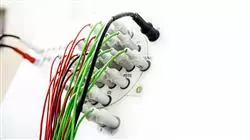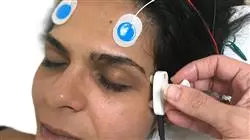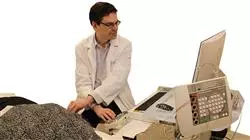University certificate
The world's largest faculty of medicine”
Description
Update your knowledge and improve your healthcare practice in the approach to patients with pathologies such as Epilepsy, Neuromuscular Disorders, Neurodegenerative Diseases or Sleep Disorders”

Neurophysiological diagnosis has undergone remarkable evolution in recent years thanks to the inclusion of new technologies and the application of multiple and varied diagnostic techniques. All of them, with a wide spectrum of indications, becoming the fundamental axis of numerous diagnostic protocols that are increasingly used by interdisciplinary teams. For this reason, the potential of this specialty is now higher than ever.
That is why it is essential for specialists to possess up-to-date knowledge that integrates the latest scientific findings in the different standards, guidelines and national and international consensus, and that homogenize criteria, maintaining high quality standards in the different sections of this extensive specialty.
It is in this context that this professional master’s degree arises, which was created with the aim of meeting these needs. With a highly practical approach, known techniques will be reviewed and updated, while several new and promising fields of application will be explored. To achieve this, TECH provides students with a teaching staff composed of a group of experts who will contribute their knowledge, practical tips and examples to support the learning process. All of this is accompanied by complementary material that will enrich the learning experience while making it more effective.
In addition to an exhaustive review of the latest guidelines and consensus, topics of great practical utility will be included, such as the use of different neurophysiological techniques in critical pediatric patients or intraoperative neurophysiological monitoring, which is increasingly requested by specialists during surgical interventions. Moreover, the program will not leave out the study of new technologies and mathematics used for signal analysis.
Given the 100% online format, students will be guided through a complete and enriching path on which they will learn all the latest developments in the profession to bring to their daily practice the most pioneering techniques in neurophysiological diagnosis. All this without giving up their personal activities, in a comfortable way and with the reliability of the most reputable academic method in the online teaching market, specialists will be able to get up to date in Neurophysiology, increasing their opportunities for personal and professional growth.
Incorporate the latest developments in Update on Neurophysiological Diagnosis and Treatment into your healthcare practice and place yourself at the forefront of your profession only by studying at TECH”
This professional master’s degree in Update on Neurophysiological Diagnosis and Treatment contains the most complete and up-to-date scientific program on the market. Its most notable features are:
- Practical cases studies are presented by medical experts in neurophysiology
- The graphic, schematic, and practical contents with which they are created, provide scientific and practical information on the disciplines that are essential for professional practice
- Practical exercises where the self-assessment process can be carried out to improve learning
- Its special emphasis on innovative methodologies
- Theoretical lessons, questions to the expert, debate forums on controversial topics, and individual reflection assignments
- Content that is accessible from any fixed or portable device with an Internet connection
Through a unique educational methodology and a 100% online format, you will be able to get up to speed in the new clinical diagnostic methods”
The program’s teaching staff includes professionals from the sector who contribute their work experience to this training program, as well as renowned specialists from leading societies and prestigious universities.
The multimedia content, developed with the latest educational technology, will provide the professional with situated and contextual learning, i.e., a simulated environment that will provide immersive specialization programmed to learn in real situations.
This program is designed around Problem-Based Learning, whereby the professional must try to solve the different professional practice situations that arise throughout the program. For this purpose, the student will be assisted by an innovative interactive video system created by renowned and experienced experts.
What is the best and most reliable way to learn and update your knowledge? Without a doubt, the answer is online learning, and you have the best method here at TECH"

Thanks to this professional master’s degree, you will develop a critical spirit when assessing results, always integrated within a clinical context"
Objectives
In taking this program, students will achieve their main goal: to acquire up-to-date and practical knowledge of the wide variety of neurophysiological diagnostic techniques available, which will be of maximum utility in the exercise of their healthcare practice or research projects. This will enable them to offer more complete, detailed and precise care to patients with neurophysiological symptomatology by detecting their pathology and adequately treating it.

At TECH, we work with you and help you achieve your goals. This method of side-by-side collaboration with students is what makes us unique”
General Objectives
- Obtain a global and up-to-date vision of neurophysiological diagnosis in its different training areas, allowing students to acquire useful and up-to-date knowledge and homogenize criteria following national and international standards
- Generate the desire to broaden knowledge within the student and encourage them to apply what has been learned to daily practice, to the development of new diagnostic indications and to research
Specific Objectives
Module 1. Brain Electrogenesis: Recording and Analysis Techniques Electroencephalogram Development
- Acquire the necessary knowledge of biophysical, analytical and technical fundamentals as a pillar for learning the genesis of graphoelements found in EEG recordings
- Look deeper into the development and chronobiology of electroencephalograms
- Learn how to identify physiological and pathological EEG patterns, as well as their correlation with age, level of wakefulness/sleep, consciousness, pharmacological interference and clinical significance
- Know how to locate abnormalities, spatio-temporal value, limitations and advantages of the technique. Identify artifacts and normal patterns that may mimic pathological graphoelements
- Become familiar with the methodology and application of quantified EEG
Module 2. Electroencephalogram (EEG) in Electroclinical Syndromes and Neurocritical Patients: Neurophysiological Precision Techniques in the Diagnosis and Treatment of Epilepsy
- Know how to diagnose electroclinical syndromes in all stages of life (specific patterns)
- Consolidate knowledge of electroencephalography applied to epilepsies, from the diagnostic phase to pharmacological, neuromodulatory and/or surgical therapeutic management
- Update on national and international guidelines and protocols for electroencephalogram use in ICUs and status epilepticus Learn pattern identification and decision-making
- Delve deeper into the methodology and application of high density EEG and generator localization
Module 3. Evoked Potentials
- Take a deeper look at the bases for obtaining the different evoked potentials
- Decide upon the most appropriate techniques for the diagnosis of different pathologies
- Interpret the results derived from these techniques
- Have access to the international guidelines for performing evoked potentials
- Delve deeper into the most common programs used in designing appropriate paradigms to obtain cognitive evoked potentials
- Delve into the peculiarities and differences in the use of evoked potentials in pediatric and critical patient settings
Module 4. Neurophysiological Techniques in the Diagnosis of Neuromuscular Diseases
- Review the practical aspects and challenges of neurophysiological examinations: How to optimize equipment for different types of examinations?
- Delve into the different types of nerve conduction studies
- Understand the rationale and technique behind performing rare sensory and motor nerve conduction studies
- Become familiar with the physiological and non-physiological factors affecting the technical aspects of nerve conduction recording
- Learn the different technical aspects and clinical applications of specialized nerve conduction procedures, such as delayed responses and blink reflex
- Recognize normal and abnormal motor unit morphology and recruitment pattern
- Recognize the clinical utility of advanced EMG techniques
- Thoroughly understand the physiology and technical aspects underlying repetitive nerve stimulation (RNS) and jitter studies, single fiber and concentric needles, with hands-on demonstrations
- Ascertain how neuromuscular ultrasound complements conventional neurophysiologic assessment
- Use ultrasound for precise localization during botulinum toxin infiltration
- Review the evidence for instrumental guidance in muscle localization (EMG/stimulation vs. ultrasound)
Module 5. Electroneuromyography (ENMG) Protocols in the Diagnosis of Neuromuscular Diseases
- Develop a logical approach to the conventional Update on Neurophysiological Diagnostic and Treatment techniques in the evaluation of focal or generalized neuromuscular disorders, neuromuscular junction disorders, including single fiber EMG
- Master the clinical and electrodiagnostic findings of focal neuropathies, plexopathies, cervical and lumbosacral radiculopathies
- Use an electrodiagnostic approach for a broad spectrum of neuromuscular disorders, including myopathies, ALS, motor neuronopathies and polyneuropathies of different nature
- Perform a correct orientation to the neurophysiological findings in the diagnosis of motor plaque diseases and their clinical correlates
- Recognize specialized electrodiagnostic modalities
- Gain insight into the peculiarities of electroneuromyographic studies in pediatric patients and intensive care units
Module 6. Intraoperative Neurophysiological Monitoring
- Look deeper into the concepts of intraoperative neurophysiological techniques
- Have the necessary theoretical and practical knowledge of the interpretation of neurophysiological signals applied to surgical settings and anesthetized patients
- Recognize the importance of alarm values and their correlation with postoperative clinical changes
- Update on guidelines and protocols
- Acquire the ability to plan, perform and assess multimodal neurophysiological techniques applied to the different fields in surgical areas
Module 7. Autonomic Nervous System: Pain Other Complex Techniques
- Look deeper into the concepts of anatomy and physiology of the autonomic nervous system and its interconnections with the pathological processes of the central and peripheral nervous system
- Understand the implications of dysfunctions in the autonomic nervous system with respect to the rest of body systems
- Handle the main test batteries to determine the different dysautonomic affectations
- Reach an adequate diagnoses in the different processes of autonomic nervous system involvement
- Update the models of dysautonomia in relation to complex regional pain syndrome or maintained sympathetic dystrophy
- Determine the relation between autonomic nervous system and peripheral and central nervous systems with central sensitization in chronic pain models
- Acquire the ability for the assessment and functional evaluation of painful processes
- Learn different less widespread, little known and novel techniques, emphasizing their use in conjunction with other health professions in the context of interdisciplinary work
Module 8. Neurobiology and Physiology of Sleep: Methodological Aspects
- Deepen knowledge of the structure of normal sleep in all stages of life and its increasing number of known functions
- Update on physiological changes during sleep, the neurobiological bases of its cycles and the influence of drugs and substances on sleep
- Update on the chronobiological mechanisms of sleep-wake cycle regulation and methods of monitoring circadian rhythm disturbances in this cycle, including the most novel and emerging ones
- Acquire the fundamental technical, methodological knowledge of suitable recording sensors, quantification and interpretation, and practical and novel aspects in polysomnography
- Update and understand other polygraphic tests during sleep and wakefulness with respect to their implementation, management and practical indications
Module 9. Clinical-Instrumental Diagnosis of Sleep Disorders
- Acquire skills for the diagnosis of insomnia, hypersomnias and circadian disturbances, through the integrated management of data and clinical tools and instrumental tests
- Possess the theoretical and practical knowledge essential for the clinical-instrumental diagnosis of respiratory disorders during sleep, from the most prevalent such as Obstructive Sleep Apnea-Hypopnea
- Syndrome, to the most recently studied, subtle and novel, such as Increased Airway Resistance Syndrome during sleep and other not so prevalent respiratory sleep disorders, but no less important, including the characterization of mixed pictures
- Acquire clinical and instrumental skills in the diagnosis of parasomnias or behavioral disorders during sleep, both in adults and in childred, with a precise update on the latest concepts and pictures in the field (dissociative states, sexsomnias, eating behavior disorders during sleep, etc.)
- Update and know the diagnostic field for prevalent motor disorders during sleep and for epilepsy during sleep, including the implication and practical consequences of the not uncommon occurance two or more coexisting sleep disorders
Module 10. Neurophysiological Techniques for Therapeutic Purposes: Invasive and Non-Invasive Neuromodulation Botulinum toxin
- Gain deeper insight into the physiological basis for different invasive and non-invasive brain stimulation techniques
- Delve into the most used indications for different invasive and non-invasive brain stimulation techniques
- Acquire the neurophysiological basis for direct cortical stimulation and its specific indications in the treatment of pharmacoresistant chronic pain
- Learn the application protocols for direct cortical stimulation in the treatment of drug-resistant chronic pain
- Acquire the neurophysiological basis for spinal cord stimulation and its specific indications in the treatment of chronic pain and other applications
- Learn the application protocols for spinal cord stimulation in the treatment of chronic pain
- Understand the role of neuromodulation in the field of epilepsy, as well as its diagnostic applications
- Acquire the neurophysiological basis for brain stimulation in the diagnosis of epilepsy
- Acquire the neurophysiological basis for brain stimulation in the Psychotherapeutic treatment Psychopharmacological treatment of epilepsy
- Know the diagnostic indications for brain stimulation in epilepsy
- Know the therapeutic indications for brain stimulation in epilepsy
- Know the role of deep brain stimulation (DBS) in Parkinson's disease (PD) and other movement disorders
- Learn the physiological basis for deep brain stimulation (DBS)
- Learn the technique and clinical indications for DBS in Parkinson's disease and other movement disorders
- Learn the physiological basis and effects of vagus nerve stimulation
- Learn the technique and clinical indications for vagus nerve stimulation
- Know the effect of vagus nerve stimulation in patients diagnosed with epilepsy
- Know the physiological basis and effects of hypoglossal nerve stimulation
- Learn the technique and clinical indications for hypoglossal nerve stimulation
- Know the effect of vagus nerve stimulation in patients diagnosed with SAOS
- Learn the basis and physiological effects of stimulating other peripheral nerves such as the trigeminal, occipital, tibial and sacral nerves
- Learn the techniques and clinical indications for trigeminal, occipital, tibial and sacral nerve stimulation
- Know the basics and fundamentals of hearing implant operations
- Know the types of hearing implants: cochlear and brainstem implants
- Learn the indications for implementing hearing implants
- Learn the physiological basis for non-invasive brain stimulation
- Learn the types of non-invasive brain stimulation: transcranial direct electrical stimulation (TES) and transcranial magnetic stimulation (TMS)
- Learn the indications for non-invasive brain stimulation
- Become familiar with the scientific evidence that supports non-invasive brain stimulation and learn the most applied therapeutic protocols
- Know the fundamentals, the basis of operation and modalities for Transcutaneous Electrical Nerve Stimulation (TENS)
- Learn the indications, contraindications and effects of TENS
- Know the action mechanism of botulinum toxin
- Learn the therapeutic and adverse effects of botulinum toxin
- Learn the technique to apply botulinum toxin guided by neurophysiological techniques in different dystonia such as cervical dystonia, blepharospasm, facial myokymias, oromandibular dystonia, upper extremity dystonia and trunk dystonia
- Acquire theoretical knowledge (definitions, indications and implementation protocols), as well as training for the practical implementation of personalized neuromodulation therapies according to the indications and following clinical protocols
- Understand neuromodulation therapies as an adjuvant treatment that is part of a multidisciplinary whole, and not as a isolated treatment

At TECH, we help you get to the top, offering you a unique and unprecedented way to update your knowledge without having to give up the rest of your activities”
Professional Master's Degree in Update on Neurophysiological Diagnosis and Treatment
In the face of permanent scientific advances and the development of increasingly effective technologies, the evolution that medicine has undergone, especially in terms of the growth of its areas of specialization, is undeniable. In the field of physiology, one of the most successful branches in recent years has been neurophysiology, because with the inclusion of new diagnostic and treatment protocols, its field of action and approach to the intervention of various syndromes and diseases of the nervous system has been strengthened. However, to perform adequately in the daily practice of this discipline, it is necessary to keep updated in neurophysiological techniques, from their indications to their utilities and clinical applications. For this reason, at TECH Global University we have developed the Professional Master's Degree in Update on Neurophysiological Diagnosis and Treatment, a program of high academic rigor with which you can specialize to offer the best care to your patients.
Specialize in the largest Faculty of Medicine
.
If you want to improve the quality of your healthcare practice by using the most advanced knowledge and technical skills to obtain better results and better prognosis guarantees, this program is the right one for you. With our Master's degree you will be able to study brain electrogenesis and its recording and analysis techniques, including the development of the electroencephalogram; electromyographic methods and protocols in the diagnosis of neuromuscular diseases; intraoperative neurophysiological monitoring; and invasive and non-invasive neuromodulation for therapeutic purposes, among other aspects. From this, you will develop the necessary medical criteria to perform your work and stand out through excellence. At TECH Global University you will take a definitive step to reach your goals and grow professionally. Enroll now in the largest Medical School!







